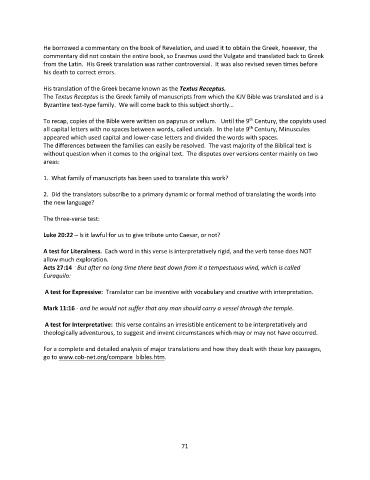Page 72 - Doctrine and History of the Preservation of the Bible Student Textbook
P. 72
He borrowed a commentary on the book of Revelation, and used it to obtain the Greek, however, the
commentary did not contain the entire book, so Erasmus used the Vulgate and translated back to Greek
from the Latin. His Greek translation was rather controversial. It was also revised seven times before
his death to correct errors.
His translation of the Greek became known as the Textus Receptus.
The Textus Receptus is the Greek family of manuscripts from which the KJV Bible was translated and is a
Byzantine text-type family. We will come back to this subject shortly…
th
To recap, copies of the Bible were written on papyrus or vellum. Until the 9 Century, the copyists used
th
all capital letters with no spaces between words, called uncials. In the late 9 Century, Minuscules
appeared which used capital and lower-case letters and divided the words with spaces.
The differences between the families can easily be resolved. The vast majority of the Biblical text is
without question when it comes to the original text. The disputes over versions center mainly on two
areas:
1. What family of manuscripts has been used to translate this work?
2. Did the translators subscribe to a primary dynamic or formal method of translating the words into
the new language?
The three-verse test:
Luke 20:22 – Is it lawful for us to give tribute unto Caesar, or not?
A test for Literalness. Each word in this verse is interpretatively rigid, and the verb tense does NOT
allow much exploration.
-
Acts 27:14 But after no long time there beat down from it a tempestuous wind, which is called
Euraquilo:
A test for Expressive: Translator can be inventive with vocabulary and creative with interpretation.
Mark 11:16 - and he would not suffer that any man should carry a vessel through the temple.
A test for Interpretative: this verse contains an irresistible enticement to be interpretatively and
theologically adventurous, to suggest and invent circumstances which may or may not have occurred.
For a complete and detailed analysis of major translations and how they dealt with these key passages,
go to www.cob-net.org/compare_bibles.htm.
71

